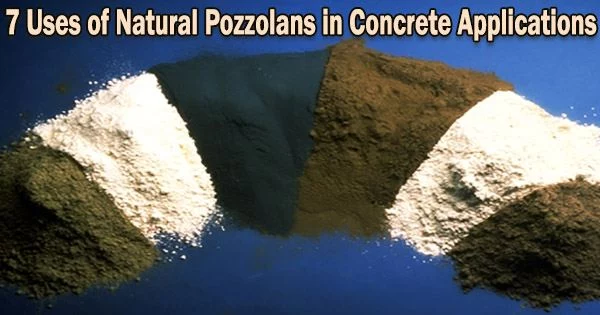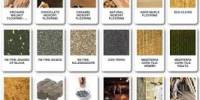Pozzolans can substitute pure Portland cement, which is frequently used in building materials including concrete, masonry block, masonry mortar, bricks, and other construction units, by blending them with lime (or Portland cement).
Structural concrete, precast and prestressed parts, mass concrete, concrete pipes, concrete masonry units, regulated low-strength materials, grout, and mortar are examples of civil projects that use natural pozzolans.
Uses of Natural Pozzolans in Concrete Applications
Structural Concrete
In order to use natural pozzolans in concrete constructions, either cement replacement materials or a natural pozzolan addition rate must be used.
Natural pozzolans improve the plastic qualities of concrete, raise the mixture’s cohesion and workability, which reduces segregation, makes consolidation easier, lowers permeability, and increases durability.
Precast, Prestressed Concrete Elements
Precast and prestressed concrete elements generate high early strength and attain acceptable durability with the aid of natural pozzolans. These requirements are crucial when using precast and prestressed concrete components to create bridges, buildings, and parking garages.
The high early strength helps early removal of formwork. However, for constructions that are exposed to harsh circumstances (moderate to severe), a high level of durability is required.
Precast and prestressed concrete structures are often in the category of moderate to severe exposure. A natural pozzolan called high reactivity metakaolin is utilized in the production of precast and prestressed concrete components.
Mass Concrete
Natural pozzolans are now present in the concrete used to build big dams.
It lessens the heat of hydration, which in turn lessens the thermal pressures that can lead to cracks in the concrete. The head of hydration reduction.
It also increases sulfate resistance and decreases the chance of expansion from alkali-silica interactions.
Concrete Pipes
When making concrete pipe, a natural pozzolan can offer a number of advantageous advantages. Cement usage is decreased while maintaining the essential workability for pipe manufacture.
The natural pozzolans improve the density of concrete pipes; minimize permeability.
Finally, a reduced likelihood of hairline crack development is caused by the lowering of heat hydration in concrete that contains natural pozzolans.
Concrete Masonry Units
Natural pozzolans are used to produce concrete masonry units. It enhances plasticity and cohesiveness, which aids in concrete compaction needed to create masonry units. Natural pozzolans lessen the durability of concrete, which reduces efflorescence formation on concrete brick units.
Controlled Low-strength Materials
A regulated low-strength fill material is created by combining natural pozzolan, Portland cement, water, and fine aggregate instead of compacted soil. Compaction is not necessary to obtain the required density, strength, and load-bearing capability.
The regulated low-strength materials are primarily used to replace compacted granular materials in situations where installation and subsequent settlement may be difficult.
The regulated low strength materials have also been used for sewage line and manhole filling as well as trench backfilling, pipe bedding, foundation sub-base, paving sub-base, floor fills, and culvert backfill.
Grout and Mortar
Natural pozzolans are used in grouts to increase sulfate resistance, decrease permeability, decrease alkali-silica reaction expansion, decrease heat of hydration, and improve workability. They are also used for economic reasons.
Mortar’s natural pozzolans may have an impact on bond strength, setting time, and other vital characteristics.
















